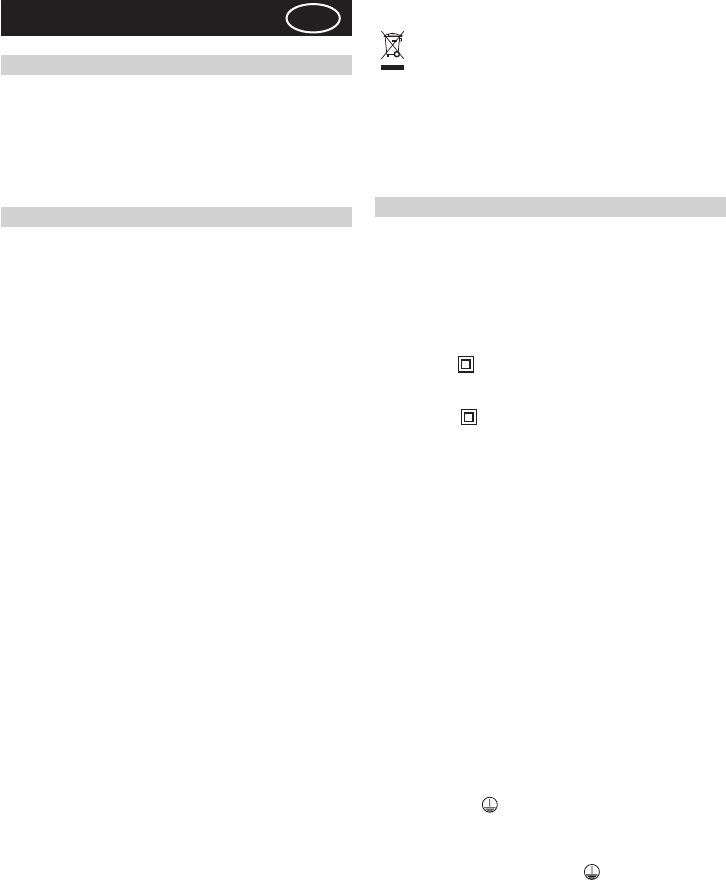
- 5 -
ENGLISH
GB
GENERAL
Carefully read the following important information regarding
installation safety and maintenance. Keep this information
booklet accessible for further consultations. The appliance
has been designed for use in the ducting version (air exhaust
to the outside – Fig.1B), ltering version (air circulation on the
inside – Fig.1A) or with external motor (Fig.1C).
SAFETY PRECAUTION
1. Take care when the cooker hood is operating simultane-
ously with an open replace or burner that depend on the air
in the environment and are supplied by other than electrical
energy, as the cooker hood removes the air from the environ-
ment which a burner or replace need for combustion. The
negative pressure in the environment must not exceed 4Pa
(4x10-5 bar). Provide adequate ventilation in the environment
for a safe operation of the cooker hood. Follow the local laws
applicable for external air evacuation.
Before connecting the model to the electricity network:
- Control the data plate (positioned inside the appliance) to as-
certain that the voltage and power correspond to the network
and the socket is suitable. If in doubt ask a qualied electrician.
- If the power supply cable is damaged, it must be replaced
with another cable or a special assembly, which may be
obtained direct from the manufacturer or from the Technical
Assistance Centre.
- This device must be hardwired to the mains supply network
by connecting to a single phase spur protected by 3A fuse.
2. Warning!
In certain circumstances electrical appliances may be a
danger hazard.
A) Do not check the status of the filters while the cooker
hood is operating.
B) Do not touch bulbs or adjacent areas, during or straight
after prolonged use of the lighting installation.
C) Flambè cooking is prohibited underneath the cooker
hood.
D) Avoid free flame, as it is damaging for the filters and
a fire hazard.
E) Constantly check food frying to avoid that the over-
heated oil may become a fire hazard.
F) Disconnect the electrical plug prior to any maintenance.
G) This appliance is not intended for use by young children
or infirm persons without supervision.
H) Young children should be supervised to ensure they do
not play with the appliance.
I) There shall be adequate ventilation of the room when the
rangehood is used at the same time as appliances burning
gas or other fuels.
L) There is a risk of fire if cleaning is not carried out in ac-
cordance with the instructions.
This appliance conforms to the European Directive EC/2002/96,
Waste Electrical and Electronic Equipment (WEEE). By making
sure that this appliance is disposed of in a suitable manner, the
user is helping to prevent potential damage to the environ-
ment or to public health.
The symbol on the product or on the accompanying
paperwork indicates that the appliance should not be
treated as domestic waste, but should be delivered to a
suitable electric and electronic appliance recycling collection
point. Follow local guidelines when disposing of waste. For
more information on the treatment, re-use and recycling of
this product, please contact your local authority, domestic
waste collection service or the shop where the appliance was
purchased.
INSTALLATION INSTRUCTIONS
•Assemblyandelectricalconnectionsmustbecarriedout
by specialised personnel.
•Wearprotectiveglovesbeforeproceedingwiththeinstal-
lation.
•ElectricConnection
Note: Verify the data label placed inside the appliance:
- If the symbol
appears on the plate, it means that no earth
connection must be made on the appliance, therefore follow
the instructions concerning insulation class II.
- If the symbol
DOES NOT appear on the plate, follow the
instructions concerning insulation class I.
Insulation class II
The appliance has been manufactured as a class II, therefore
no earth cable is necessary.
The plug must be easily accessible after the installation of the
appliance. If the appliance is equipped with power cord with-
out plug, a suitably dimensioned omnipolar switch with 3 mm
minimum opening between contacts must be tted between
the appliance and the electricity supply in compliance with the
load and current regulations.
The connection to the mains is carried out as follows:
BROWN = L live wire
BLUE = N neutral
Insulation class I
This is a class I, appliance and must therefore be connected
to an eecient earthing system.
The appliance must be connected to the electricity supply
as follows:
BROWN = L live wire
BLUE = N neutral
YELLOW/GREEN = earth
The neutral wire must be connected to the terminal with the
N symbol while the YELLOW/GREEN, wire must be connected
to the terminal by the earth symbol .
Warning:
When connecting the appliance to the electricity supply, make
sure that the mains socket has an earth connection. After tting
the ducted cooker hood, make sure that the electrical plug is
in a position where it can be accessed easily. If the appliance
is connected directly to the electricity supply, an omnipolar
switch with a minimum contact opening of 3 mm must be
placed in between the two; its size must be suitable for the
load required and it must comply with current legislation.
•The minimum distance between the support surfaces of














